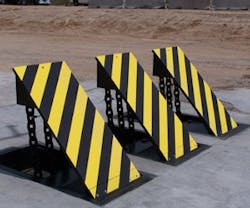Whether as part of a terrorist attack or a driver going into a diabetic coma, a speeding vehicle can cause serious damage to your facility.
A vehicle control access system hardens your perimeter and creates a single access point. "Barriers are a visible sign that you are taking a proactive approach to your security and you've thought out your contingency plan," says Michael Wood, a security forces member of the Air National Guard.
Barricade Benefits
While not all buildings are vulnerable to terrorist threats, many can benefit from vehicle access control measures. "A vehicle barrier represents a physical line that cannot be crossed without authorization," says Wood. In addition to serving as an immediate deterrent to criminals, vehicle control systems
- Create a choke point
- Reduce traffic speed and density
- Increase safety of pedestrians
- Allow guards to conduct searches
- Repel speeding vehicles
Facilities that are critical to infrastructure, produce hazardous materials, contain valuable assets, have heavy cargo traffic or house political organizations or legal institutions should consider a vehicle control system. Because of inexperienced drivers, even school grounds can benefit from barriers.
There are hundreds of barricades that can be specifically tailored to your facility. Common barriers include wedges, plates, drop arms, bollards, crash and sliding gates, and cabling systems. These can be manual or automated, surface or foundation mounted, hydraulic or pneumatic, and portable or permanently installed.
Vehicle barriers are only one part of your overall security system. Each option can be tied to guard booths, radar, smart cards, or surveillance. They need to coexist with other hardening measures such as shrubs, tree lines, and perimeter fencing.
Most require little to no energy use and only need quarterly maintenance such as oil changes. Barriers are available with crash ratings and in materials ranging from plastic and wood to industrial steel and concrete. While prices vary, all outweigh the damage expenses created from a vehicle breach.
The Right Barrier
The system you need depends on the design of your entrance points and your vehicle capacity. "Our rule is to always use the smallest barricade that will do the job," says David Dickinson, senior vice president for Delta Scientific, a manufacturer of vehicle access systems. "We look at the size, weight, and speed of vehicles as well as frequency levels."
If you have a narrow entrance or one with many curves, metal bollards will force cars to slow down. A large permanent system offers a higher level of protection for a facility where vehicles could gain speed down a straight road.
Volume should also be accounted for, explains Dickinson. A building with multiple lanes needs active barriers that can cycle quickly whereas access to a parking garage may require a passive system.
Some locations may require an aesthetic option, which bollards can offer. Buildings with prominent entrances – such as historic facilities, universities, entertainment venues, or high-profile businesses – use bollards for a sophisticated or muted look.
Peace of Mind
Vehicle barriers can be a "set it and forget it" method or manned with trained guards. While a guard booth and security personnel represent a higher level of investment, it also adds an important human element – judgment.
Wood experienced a situation where the identity of a contractor could not be verified and the individual attempted to cross the threshold in a truck. By actuating a mobile bollard system, the barrier caught the F250 pickup truck under the wheel well and lifted the front end 3 feet into the air.
From an inebriated person to a hostile act, there are times when the gravity of a potential threat necessitates human and technological intervention. Having security personnel tied to the vehicle system heightens its effectiveness as well as adds another layer of risk mitigation.
"Vehicle barriers are a form of insurance," says Dickinson. "If your facility is even moderately hardened, criminals are going to look for an easier target.
Jennie Morton ([email protected]) is assistant editor of BUILDINGS.
About the Author
Jennie Morton
A former BUILDINGS editor, Jennie Morton is a freelance writer specializing in commercial architecture, IoT and proptech.
